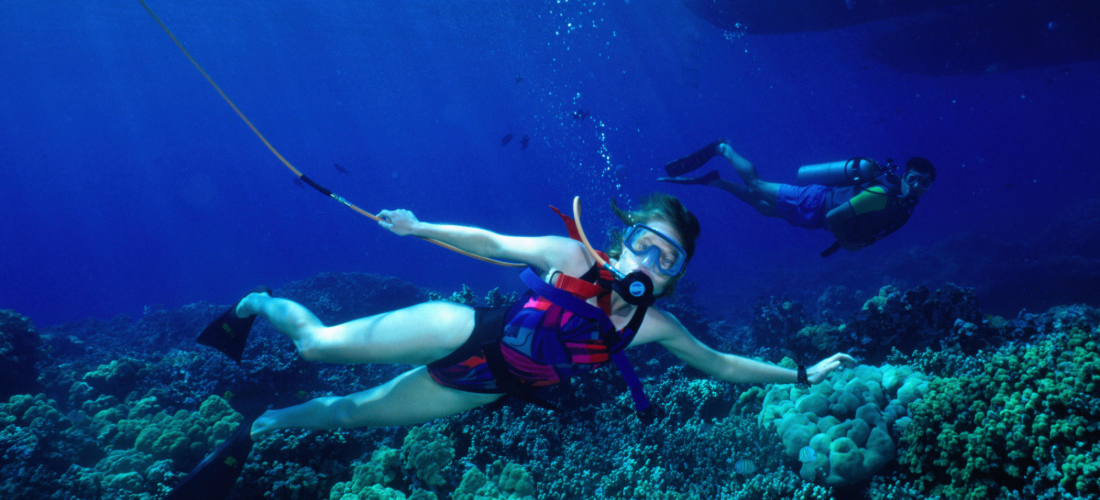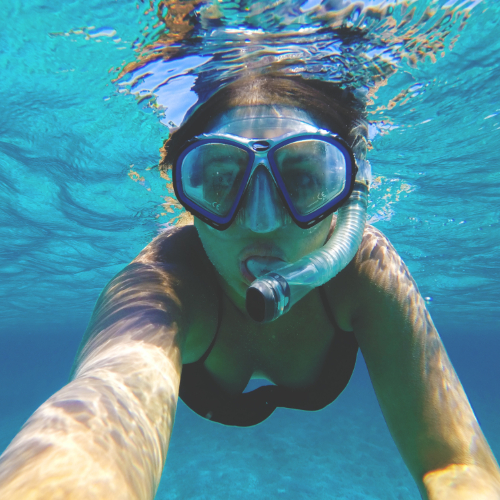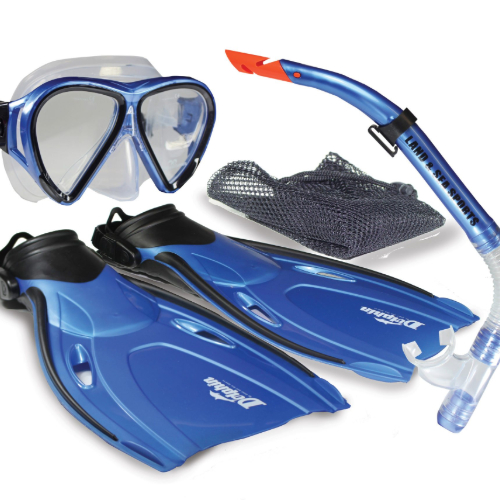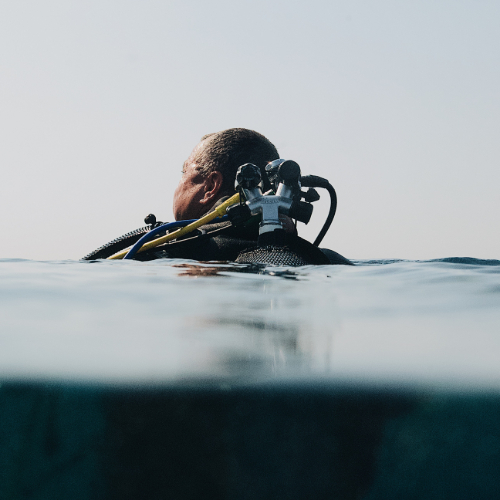Should you snorkel or should you scuba dive? Well, it all depends on how much you want to see of the underwater world and the effort you want to put into practicing a water activity. There’s still a lot of confusion surrounding the difference between snorkeling and scuba diving, but we’re here to clear it up. Here’s our take on the snorkeling vs scuba diving debate.
Snorkeling vs Scuba Diving
Training and Certification
Snorkelers are not required to undergo training or show a certification card before going into the water. However, because of a number of risks both the practitioner and the environment are exposed to, some dive professionals do see the need of prior training. Snorkelers are known to have caused damage to reefs in various regions of the world. Not only this, but poor swimming abilities, lack of knowledge about currents and marine life, as well as some snorkelers’ need to venture too far down from the surface puts their own life at risk.
Scuba divers need to undergo special training before their very first dive as well as before obtaining any other certification they wish to cross off their list. After successfully completing the training, the training agency will emit a certification card (or a diver’s C-Card). Once certified, you’re certified for life. Dive operators, sale shops, and rental shops all require divers to show their card before diving, purchasing or renting out dive gear.
Age Limit
There’s not a generally established age limit for snorkeling, but it is generally assumed that anyone aged 5 and up can snorkel if they feel comfortable being in the water. However, some snorkel operators may increase the age limit if the water and weather conditions at some of the snorkeling sites are unsafe for kids.
Renowned scuba diving agencies like PADI and SDI have set the minimum age for open water dives to 10 years old. Nonetheless, PADI and SSI allow kids as young as 8 to take their first breaths underwater in a pool or under confined water conditions in a protected and shallow area. Juniors can then become fully certified divers around the age of 15 when they can obtain their Open Water certification after undergoing additional training.
Health Requirements
Snorkeling is easy on the body, but just as scuba diving, it does require good cardiovascular health. Snorkelers should also be fit so they can swim back to the shore or boat if they ever get carried away by the currents. It’s also important not to go into the water if you have a cold or if you’re suffering from sunstroke.
Scuba diving puts a strain on the body, as the pressure you experience underwater affects your body in more ways than one. This is why before each diving course scuba students must fill out a medical questionnaire (such as this medical statement from PADI). Heart problems, lung problems (such as asthma), ear issues, allergies, and many other diseases and conditions can cause serious harm to the diver underwater. It’s important to consult with your doctor to determine if you are medically apt to scuba dive.
Equipment
Snorkeling gear includes just a few basic pieces of equipment:
- Snorkel
- Diving mask
- Fins
Scuba diving gear is made up of many different items. The basic requirements include:
- Pressurized gas tank
- Two-stage regulator
- Wetsuit or drysuit
- Fins
- Dive computer
- Submersible Pressure Gauge
- Buoyancy Compensator
Breathing Technique
Snorkelers use a snorkel tube to breath in the air from the surface. Consequently, they need to keep their snorkel tube above the surface to allow breathing. If they decide to go underwater, the snorkel might flood. A dry snorkel, however, allows snorkelers to dive a bit deeper, as the top end of the tube automatically seals itself when submerged into water.
Scuba divers use a scuba tank containing a breathing gas mixture and a two-stage regulator. The latter’s role is to reduce the pressure of the breathing gas from the tank to that of the ambient pressure of the water surrounding the scuba diver and to deliver the gas via a mouthpiece. Divers can then breath as if they were on the surface.
Exploration Depth
Snorkeling tubes are short and can only allow one to dip their face into the water, so you won’t be able to see the beauty hidden in deeper waters. Besides, the human lungs can only operate against a pressure of 0.05 atm tops, while the water pressure increases by 1 atm for every 10 meters descended. So even if a snorkel could allow a deeper descent, it would still be physically impossible to go too far underwater with the basic snorkeling equipment without risking your health.
Scuba diving allows one to explore the underwater world at far greater depths than snorkeling. You can basically dive as deep as your certification, training, equipment, and gas supply allow it. In recreational diving, the maximum depth limit is 40 meters (130 feet), while technical divers can venture deeper than 60 meters (200 feet). The Guinness World Record for The Deepest Scuba Dive is currently held by Ahmed Gabr who dived to a depth of 332.35 meters (1,090.4 feet).
Water Time
Snorkelers can spend as much time in the water as they want as long as they come out at regular intervals to breathe.
Scuba divers can remain underwater until the amount of gas in their tanks runs out. But what this actually means is that they have to return to the surface with a safe reserve of breathing air still in the tank (usually 500 PSI or 50 bar). Most divers stay underwater for 45-60 minutes. In case of a multidive, the dive computer can also indicate when it’s time to return to the surface.
Risks
Snorkeling is a low-risk activity. The main issues that may occur include jelly stings, suffering lacerations from reefs and rocks, and getting sunburns. More serious risks include drowning and being hit by a jet ski or a motorized boat.
Scuba diving is considered a low-risk activity too, but it does come with more dangers than snorkeling. The main scuba diving risks are decompression sickness, drowning, gear malfunction, and hypothermia, among others.
Post-activity Considerations
Once you’ve finished snorkeling for the day, you’re pretty much free to do whatever you want. Just make sure you don’t step on the reef on your way out of the water, as it not only damages the ecosystems but can also cause lacerations to the practitioner.
After scuba diving, there are certain safety rules you need to follow so you don’t put your health at risk. Flying after scuba diving – or any other activity such as hiking or ziplining that causes a change in altitude – should be avoided for the next 24 hours from your last dive. Alcohol and intense physical activity should also be avoided because just as being at an elevated altitude, it can increase the risk of developing decompression sickness.
Snorkeling vs Scuba Diving – Is One Better than the Other?
There’s more than one difference between snorkeling and scuba diving. There are many factors you need to consider, from how healthy you are to how involved you want to get. Scuba diving not only requires training but it’s also far costlier than snorkeling. On the other hand, snorkeling doesn’t really allow you to explore as much of the vast sea as you may want to. In the end, there’s no winner or loser – simply should choose what suits you best.
What’s your take on snorkeling vs scuba diving? Let us know in the comments below.







One thought on “Snorkeling vs Scuba Diving: 9 Differences You Need to Know About”